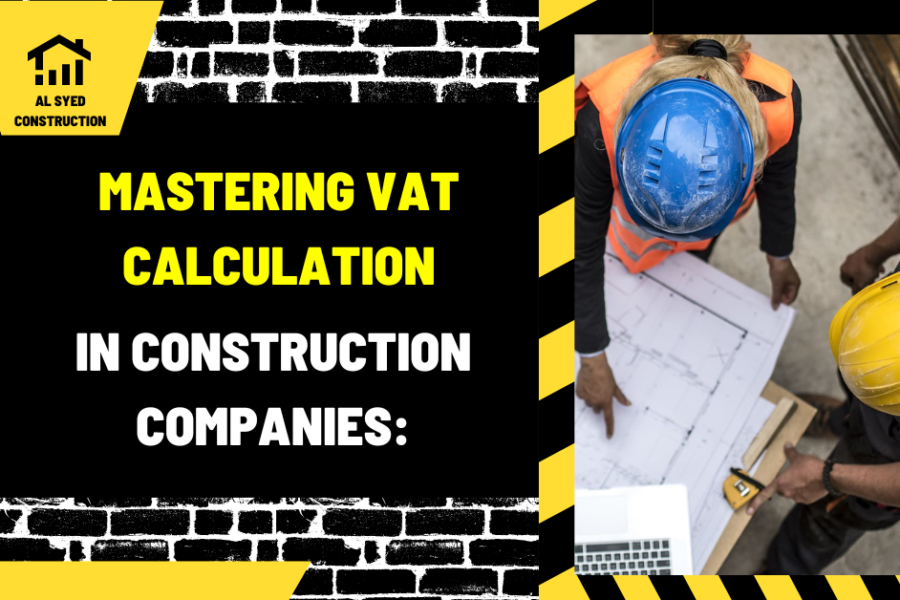Mastering VAT Calculation in Construction Companies: A Comprehensive Guide
Table of Contents
Introduction:
Value Added Tax (VAT) is a critical aspect of financial management for construction companies. Accurate VAT calculation ensures compliance with tax regulations and helps in managing finances effectively. However, VAT calculation in construction can be complex due to various factors such as different types of projects, subcontractors, and materials involved. In this guide, we’ll delve into the intricacies of VAT calculation in construction companies and provide practical steps to streamline the process.
Understanding VAT in Construction:
Before delving into the calculation process, it’s crucial to understand the basics of VAT in construction. VAT is a consumption tax levied on the value added to goods and services at each stage of production or distribution. In construction, VAT applies to both goods and services provided, including materials, labor, and subcontracted works.
VAT Rates:
Construction projects may involve different VAT rates depending on the type of work and materials involved. In most cases, construction services are subject to the standard VAT rate. However, certain projects, such as renovations to residential properties, may qualify for reduced VAT rates. It’s essential to identify the applicable VAT rates for each aspect of the project to ensure accurate calculation.
Input VAT and Output VAT:
In construction, VAT calculation involves both input VAT (VAT paid on purchases) and output VAT (VAT charged on sales). The difference between output VAT and input VAT determines the VAT liability or refund owed to the tax authorities.
Calculating VAT in Construction:
- Identify Taxable Supplies: Begin by identifying all taxable supplies related to the construction project, including materials, labor, and subcontracted services.
- Determine VAT Rates: Determine the applicable VAT rates for each taxable supply based on the nature of the work and materials involved. Keep in mind any reduced VAT rates or exemptions that may apply to specific items.
- Calculate Output VAT: Calculate the output VAT by multiplying the taxable amount by the applicable VAT rate for each supply. This includes any additional charges such as markup or profit margin.
- Compute Input VAT: Calculate the input VAT by summing up the VAT paid on purchases of materials, subcontracted services, and other expenses directly related to the construction project.
- VAT Adjustment: Make adjustments for any VAT incurred on purchases that are not directly attributable to taxable supplies, such as overhead costs. These adjustments ensure that only relevant input VAT is included in the calculation.
- Net VAT Calculation: Determine the net VAT liability or refund by subtracting the total input VAT from the total output VAT. A positive value indicates VAT payable, while a negative value indicates a VAT refund.
- Submit VAT Returns: Submit VAT returns to the tax authorities within the prescribed deadlines, along with the necessary documentation to support the calculations.
Challenges in VAT Calculation:
Calculating VAT in construction can be challenging due to various factors, including:
- Complex Supply Chains: Construction projects often involve multiple contractors, subcontractors, and suppliers, making it difficult to track and reconcile VAT transactions.
- Partial Exemption: Construction companies may be subject to partial exemption rules, which require careful calculation of recoverable and non-recoverable VAT on expenses.
- Reverse Charge Mechanism: The reverse charge mechanism applies to certain construction services where the recipient, rather than the supplier, is responsible for accounting for VAT. Understanding and implementing this mechanism correctly is essential for accurate VAT calculation.
- VAT Recovery on Costs: Maximizing VAT recovery on costs requires a thorough understanding of the rules governing input VAT recovery, including the treatment of capital goods and non-deductible expenses.
Best Practices for VAT Calculation:
To streamline VAT calculation in construction companies, consider the following best practices:
- Maintain Accurate Records: Keep detailed records of all transactions, including invoices, receipts, and contracts, to support VAT calculations and ensure compliance with tax regulations.
- Utilize Accounting Software: Invest in accounting software specifically designed for construction companies to automate VAT calculations, invoicing, and reporting tasks.
- Stay Updated on Tax Regulations: Stay informed about changes to VAT laws and regulations that may impact construction projects, and adjust your processes accordingly to remain compliant.
- Seek Professional Advice: Consult with tax advisors or accountants with expertise in construction VAT to ensure that your calculations are accurate and compliant with regulations.
Conclusion:
VAT calculation is a fundamental aspect of financial management for construction companies, requiring careful consideration of various factors such as project type, VAT rates, and supply chain complexities. By understanding the principles of VAT in construction, implementing best practices, and leveraging technology, companies can streamline the calculation process, ensure compliance with tax regulations, and optimize financial performance.





Leave a Reply
Want to join the discussion?Feel free to contribute!